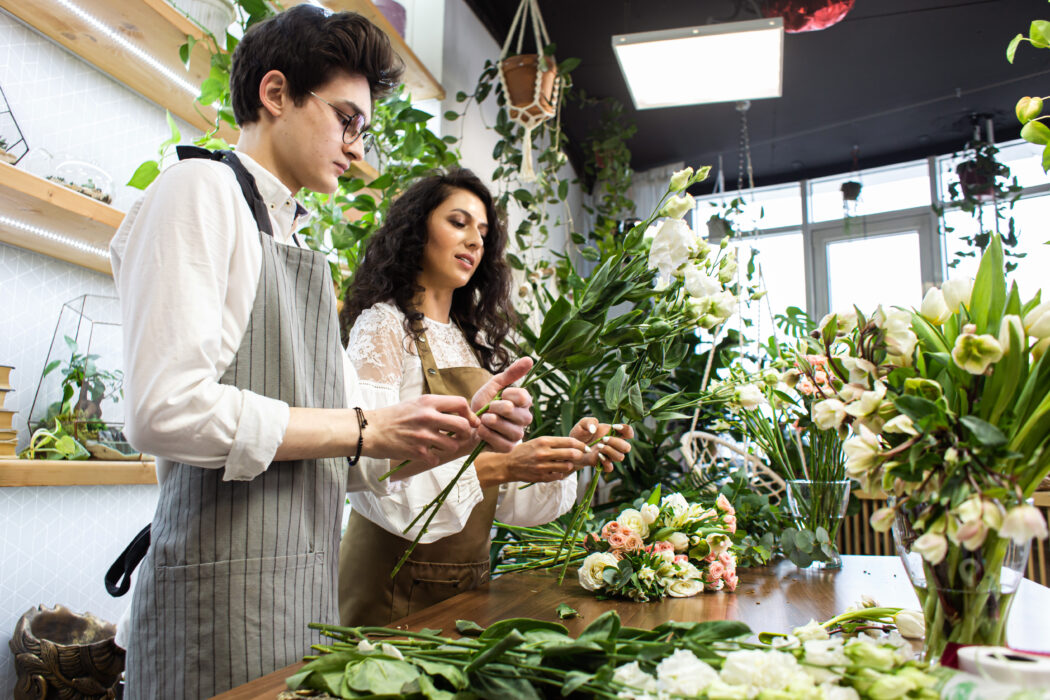Floral Designers belong to the Artistic Theme Code Category of the Strong Interest Inventory® (SII). The Strong Interest Inventory was released in the 1920s and was originally designed to help people searching for careers narrow the scope of their job search. This interest inventory works in a two-step process. First, job seekers take a comprehensive assessment that delves into their preferences and proclivities, including their preferred work environment, subject area interests, degree of workplace flexibility, and more. Next, it compares individuals’ responses to those of professionals in hundreds of different careers. Individuals whose responses are similar to those of interior designers, musicians, or museum curators, for example, would be guided towards those career types. Moreover, the SII organizes careers into six categories based on key characteristics. Floral Designers are considered Artistic careers because they tend to attract creative people who enjoy flexible environments and value the opportunity to use a physical medium to express themselves.
Floral Designers design and create arrangements of artificial, dried, or live flowers and other plants or foliage. Arrangements may include wreaths, bouquets, boutonnieres, corsages, arches, or other items. In addition to the plants, Floral Designers may also use wire, pins, foam, tape, trimmers, ribbons, and other artistic or craft materials. Some Floral Designers work independently and on individual projects, while others work for a larger company such as a wedding venue or grocery store. Most Floral Designers offer some “off-the-shelf” products, such as bouquets stocked for immediate purchase. Typically, they also offer custom arrangements. Custom projects start by meeting with clients to discuss the type of arrangement they are looking for and any specific plants or colors they would like to include. This initial meeting also covers logistics like price and the delivery date, time, and location. Then, the Floral Designer must design, plan, and create the arrangement in accordance with the client’s requests. Their expertise includes design principles and aesthetics, as well as the properties of the materials themselves. For example, different plants in the same arrangement may need similar light, water, and temperature to remain fresh and vibrant.

Utilize The Strong Interest Inventory to find your best-fit Career
In addition to their artistic expression, Floral Designers may also need to manage business operations and logistics. Such responsibilities vary depending on their organization and the specifics of their role—the owner of a floral design company will have different responsibilities and skill sets than an apprentice. However, tasks typically include ordering or purchasing flowers or other supplies directly from growers or wholesalers; unpacking and storing deliveries as they arrive; managing product storage and inventory; watering, cutting, and cleaning, and otherwise maintaining flowers or foliage; wrapping and pricing arrangements once they have been completed; and coordinating delivery arrangements, even if they are not delivering their arrangements personally. Those who work in retail environments may also be responsible for creating window displays or planograms, interacting with customers, and performing other retail service duties.
To be successful, Floral Designers must be familiar with the materials used to create arrangements, including flowers and other foliage and any necessary crafting materials. They should also be comfortable working with computers, tablets, cell phones, and standard office software (e.g., web browsers, e-mail software, word processors, schedulers, and accounting and inventory management software). Most Floral Designers develop the skills to be successful on the job through apprenticeships and work experience rather than through formal education. According to data from the Bureau of Labor Statistics, 76% of Floral Designers hold a high school diploma or GED, while 11% have completed some college without a degree. Just 8% hold a Bachelor’s degree.
The median salary for Floral Designers in the United States is approximately $14.36 per hour, which comes to $29,880 per year. That said, there is some variation in different parts of the country. Floral Designers in states like New York and California have a median salary closer to $36,000 per year, while those in Louisiana or Idaho earn closer to the national median. Current and future employment trends are also important when evaluating career options. As of 2020, there were 42,300 Floral Designers employed in the United States. Across the country, this is projected to decline slightly in the next decade. While there are expected to be 2,600 new positions as Floral Designers, the expected retirement rate is higher, resulting in a net decline in employment.
Below are some employment trends for Floral Designers in the United States:
- Median Salary: $29,880 per year, $14.36 per hour
- Employment: 42,300 employees
- Projected growth (2020-2030): Slight decline (-1%)
- Projected job openings (2020-2030): 2,600
Visit Our Myers-Briggs Type Indicator® Career Resource Database for Information on MBTI® Personality Type Careers
To Learn More About the Myers-Briggs Type Indicator, visit our About MBTI Test Page
Explore our Strong Interest Inventory® Blog Pages:
- Strong Interest Inventory Realistic Theme Explained
- Strong Interest Inventory Artistic Theme Explained
- Strong Interest Inventory Investigative Theme Explained
- Strong Interest Inventory Social Theme Explained
- Strong Interest Inventory Enterprising Theme Explained
- Strong Interest Inventory Conventional Theme Explained
Assessment Categories
References
- Bureau of Labor Statistics wage data and 2012-2022 employment projections Onetonline.org









